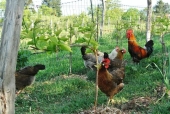The problem with feeding your birds only worms is that they much prefer a wide variety of foods. Chooks are more omnivorous, they will want greens, bugs, worms, veggies (all kinds), they love watermelon, cantaloupe, pumpkin and all the other squashes, tomatoes are awesome to them too.
I'd suggest to simply grow twice as much produce than your family will need, half for the family, half for the chooks.
As Lorenzo pointed you towards, there are much more sustainable, better ways to feed your chooks than from just a worm farm (use those for treats to get them inside in the evening).
Meal worms are another good treat item. You did mention that you are going to free range them, they will, for the most part, feed themselves then.
We use composting worms and meal worms for treats and enticements but not as part of their regular "supplied food", most of their food they get on their own as they free range the homestead farm.
We keep them in the "lockup run" while we are away at work during the week, they are let out when we arrive home, they fully free range on the weekends.
In the "lockup run" they have a deep litter,
compost to happily scratch through for food.
we do have some feed set out in the lockup run but it is touched only when they have eaten everything else.
The compost method gives you a way to utilize your kitchen scraps more than once, the chickens eat what they want and the rest decomposes, attracting bugs and worms that the chickens will then eat.
If you want the tastiest meat and eggs from your chooks, the wide variety of food stuffs style of feeding will best serve your needs.
It would take somewhere around 50-100 worms (or more) per bird per day, every day to keep them on a worm diet.
I've seen a single leghorn gobble up 50 like it was nothing, our neighbor tried worms for one week then went back to total free ranging his chooks and guineas.
Worms don't reproduce enough for a small operation to provide enough to be sustainable as a food source for even as few as 6 chooks.
I'm setting up a three bin worm farm but not for feeding the chooks, it is more for fishing and some chook treats.
The Wallapini green house is a grand idea for over wintering your worm farms, in the summers, open it up and put up shade cloth (if needed) to keep them cool enough.
I'm even thinking of setting up a worm farm for true earth worm production, it will need to be much deeper than the wriggler set up.

 1
1









 2
2




















































